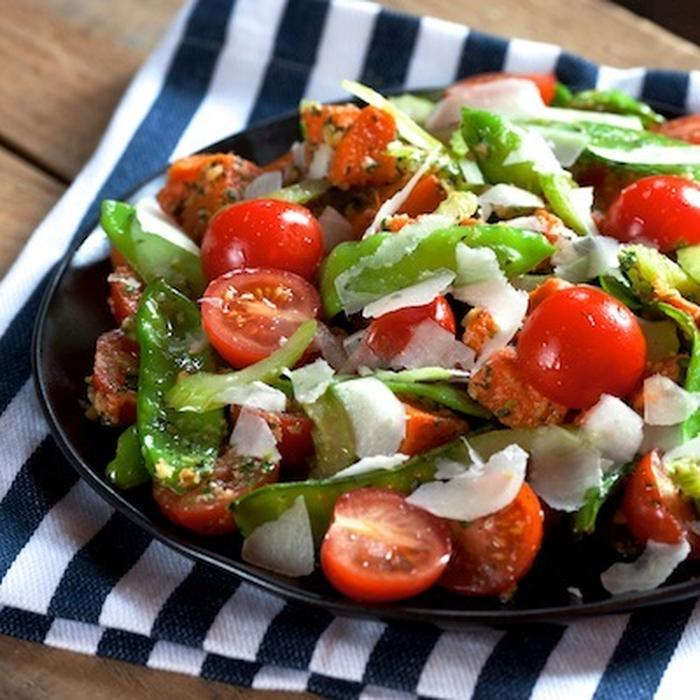
Dear Blue Apron,
With summer produce around in abundance, I’m trying to get more vegetables in my diet. In fact, I need to: I’ve been overbuying at the farmers’ market and have tons of produce sitting in my fridge. But I have a hard time thinking of creative ways of incorporating all those veggies into my everyday meals—rice, chicken, sandwiches, the usual. How can I eat more vegetables without simply preparing salad after salad?
Thanks!
-Squashed
Dear Squashed,
The colors, shapes, and textures at the farmers’ market make the best of us overfill our baskets. It’s only natural, and you’re right—there’s no better way to celebrate the season than by stocking up on the best produce around.
At the same time, it’s no fun to waste that glorious haul. Plus, all those vegetables are really good for you, and it’s a shame not to get all these minerals and vitamins while they’re sitting there fresh and waiting for you to enjoy them.
Let the veggies take you out of your comfort zone of sandwiches and chicken dishes, adding new flavors and textures to your everyday meals. Here are a few ways to become the most creative veggie lover your kitchen has ever seen.
1. Chop and Add
It’s as simple as this: Anywhere you didn’t have a vegetable before, add one now. You’ll use up your vegetables, stay close to that comfort zone, and bulk up your meals without adding a lot more calories or work.
Take anything in your crisper drawer, wash it, chop it, and add it to your sauté, sauce, or sandwich while you cook. Instead of plating your fish or meat on top of rice, try building around a vegetable sauté of corn and eggplants. Turn fresh red peppers into a not-too-spicy red pepper salsa to put on top of grilled chicken or add a little zest to your sandwich. Throw asparagus and artichokes into your potato side dish. Pile carrots, cabbage, and cucumbers onto your banh mi sandwich.
In general, add any hard vegetables around the same time as you start to sauté the onion, and throw in softer ones like zucchini closer to the end of cooking.
With a little creativity, you’ll be able to incorporate your produce in no time.
2. Put the Produce in the Spotlight
Sure, there’s a time for hiding the produce, slipping it into your spaghetti or pizza. But there’s also a time for letting it shine.
An easy way to do this is replace the meat in your meal—which usually takes center stage—with a veggie substitute. Lose the meat in tacos and replace with grilled zucchini planks. Instead of serving spiced lamb over Israeli couscous, try this vegetable roast made with gorgeous baby carrots, summer squash, and fresh radishes. Replace steak with carrots or cod filets with cauliflower in your favorite preparations, and you’ll be right on track.
3. Make Lettuce-Free Salads
Salads truly are a great way to enjoy fresh produce, but if you feel like you can’t look at another leafy green, ditch the lettuces and focus on the fun toppings. Let’s call them “tosses.” Or “bowls.” The idea here is to combine allied ingredients, perhaps with a dressing, in a way that seems coherent rather than hodgepodge.
Okay, maybe a little hodgepodge.
To make it feel like a full meal instead of a hippie-style assemblage of parts, make sure to combine lots of different textures and have some more filling grains or starches in addition to lighter ingredients. Pair crunchy ingredients with creamy ones and think about combining ingredients that come from the same part of the world to achieve a delicious dish. Two of our favorites are a filling sweet potato and snow pea toss and a delicious lentil salad that boasts radicchio, radishes, and sliced fennel.
4. Make Pesto
Almost any green vegetable can be turned into pesto, that luxurious Italian sauce made from nuts, olive oil, cheese, and basil. Replace the not-so-quintessential (and oh-so-expensive) basil with whatever is lurking in your fridge. Herbs like parsley and tarragon are good choices, as are green veggies like arugula, kale, and even broccoli. You can even use parts of plants that you would usually throw in the trash, like the greens of carrots or beets.
Then, use this tasty pesto to boost the veggie power of any dish. Obviously, you can enjoy it on pasta. But you can also add a little more oil to the sauce and use it as a dressing for one of your salads or bowls. For example, toss pesto onto a mix of sweet potatoes, snow peas, cherry tomatoes, and celery for a punchy and veggie-rich base for any meal.
Now—go ahead. Go crazy at the farmers’ market. Bring home tote bags full of produce. You’ve now got the power to eat all of it up.